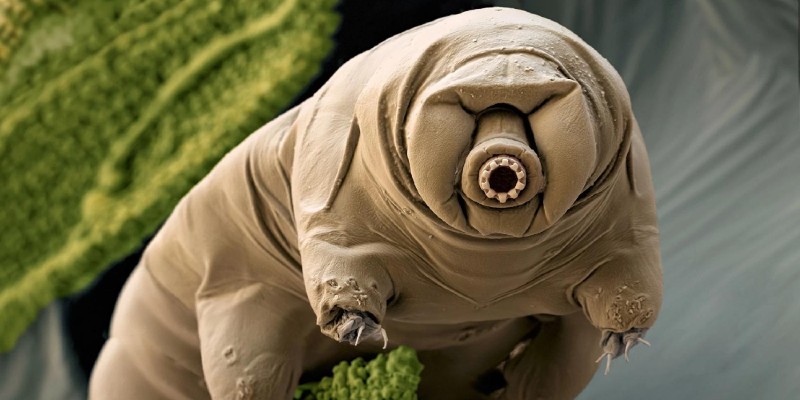
Who do you think is the toughest creature on Earth–Lions, Elephants, or the tiny cockroach that survived the asteroid that killed the dinosaurs?
Well, what if we told you there’s a creature that combines all the qualities of the toughest animals and more but is less than 1 millimetre in size? Meet the Tardigrade.
The tardigrade is a fascinating microscopic creature that can live anywhere, including the deepest oceans and even outer space. It can withstand just about any hostile environment – extreme heat, extreme cold and more!
So what are tardigrades and what makes them so tough? Let’s find out.
Tardigrades are micro-animals that are literally found everywhere on Earth. There are more than 1,300 species of tardigrades. Much like a lot of lichens (plantlike organisms) that grow everywhere, tardigrades can be found in the ice caps of Antarctica, in the deepest Mariana Trench, on top of the Himalayas, and even in your garden!

A tardigrade under a microscope. Source: Flickr
On closer inspection, a tardigrade looks like an adorable mini-bear, which is why German zoologist Johann August Ephraim Goeze named them ‘Kleiner Wasserbär’ or ‘Little Water Bears’ in 1773. They were later named tardigrades, meaning ‘slow walkers’, by Italian biologist Lazzaro Spallanzani in 1777.
Unlike other micro-animals, tardigrades don’t need water to survive. When they’re removed from the water and dried, tardigrades accommodate themselves accordingly. They tuck in their legs and head and turn into small, hard tablets called ‘tun’. In this state of tun, tardigrades secrete certain substances that coat them completely, forming a tough and sustainable casing that protects them from almost everything.
Tardigrades can withstand extremely high and low temperatures that would generally kill other living beings. Some species of tardigrades have survived below -200 degrees Celcius temperatures and even reproduced after being unfrozen. Some have even been put in boiling water and come out alive!

Tardigrades or ‘little water bears’ can survive anywhere. Source: Flickr
Tardigrades can hold up well under extreme pressure too. Scientists examined these microscopic creatures at the bottom of the Mariana Trench, the deepest point on the ocean floor – a point of such intense pressure that most animals wouldn’t survive. But the tardigrades were witnessed scuttling about as if it was no big deal!
In their tun state, tardigrades don’t require food or water to survive. They reduce their metabolic process almost completely in order to preserve themselves. With this, they go into a hibernation state. But even after 100 years, they can be rehydrated and brought back to life.

Tardigrades can be found everywhere in the world. Source: Flickr
Tardigrades are the only organisms that have survived exposure to space and radiation. In 2007, the European Space Agency sent a satellite into space, carrying tardigrades that were in tun form. After reaching, they were exposed to cosmic radiation and the vacuum of space. The tardigrades returned 10 days later, and upon rehydration, they survived perfectly.
Tardigrades are often the first organisms to set up an ecosystem in harsh and inhospitable areas. Tardigrades collect all the essential elements like nitrogen, oxygen, etc., so that they can pass them on to other life forms like small plants and animals.
Now that you know about this microscopic superhero, what’s one feature you’d borrow from the tardigrade? Let us know in the comments below.
Explore the fascinating world of animals with Knowledge Vine:
How are Cold-blooded and Warm-blooded Animals Different?
Madhavi is passionate about everything to do with books, art, literature, films, trivia and food. A former journalist, she believes that asking questions makes life interesting.